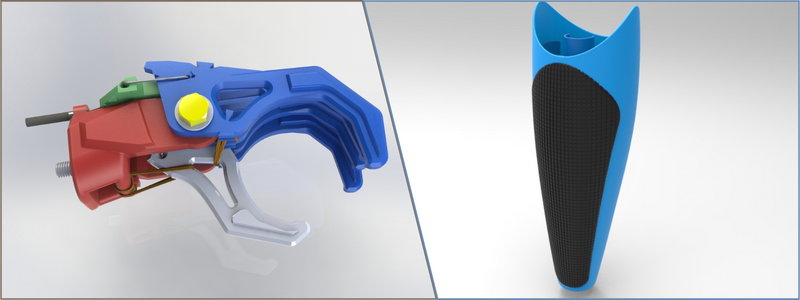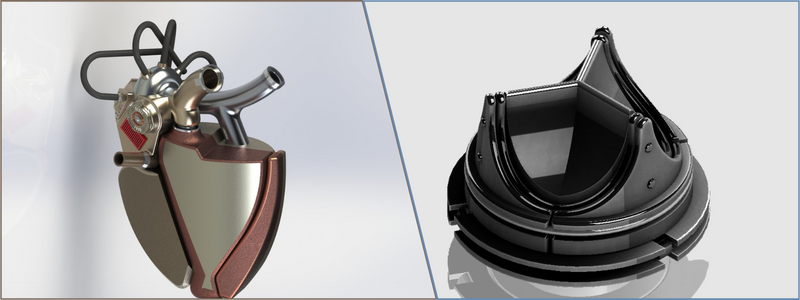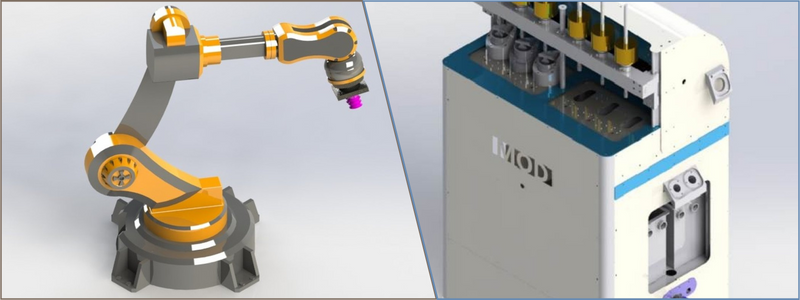3D Printing and 3D bioprinting can benefit the healthcare industry and treating patients – in this post we’ll be telling you everything you need to know. Advancement in 3D printing technology has attracted genuine interest from the medical industries. The possibility of printing prosthetics and plastic dentures based on patient-specific anatomy is only the tip of the iceberg. Newer types of metal 3D printers, using actual metal powder filament rather than metal-colored plastic, also spark excitement among medical tools manufacturers. One of the latest developments, 3D bioprinting, is even more groundbreaking.
Instead of using filaments like plastic and metal to create inanimate objects or tools, bioprinting engineers use bioinks to make living organs and tissues. 3D printing and bioprinting are the obvious steps of progression in the medical world concerning patient treatments, including prostheses, dental works, surgical preparation, drug testing and discovery, and disease modeling for research.
RELATED: How to design medical products that people actually want
3D printed prostheses
Let us start with the most widely cited application: prostheses. Unless done with surgical precision, the conventional manufacturing method of prostheses is known to produce expensive yet uncomfortable prosthetic body parts. While 3D printing with the help of a prosthetic design company can be costly, it is much more cost-effective and promises higher accuracy. Thanks to a combination of a 3D scanner and 3D printer, every patient can get a perfect fit; it is like a tailor-made artificial body part designed for comfort.
Development in the 3D printing industry has led to higher-strength filaments, too. Some 3D printed prosthetic projects have been done on behalf of injured people from natural disasters or war refugees. Not only does the technology bring hope for the quality of life of patients, but it also ensures that such a hope is within reach.
RELATED: 3D Printing Services, Cost and Rates for Companies and Firms

3D printed dental works
From general dentistry to orthodontics, 3D printing services is an invaluable resource for dentists and patients. The fabrications of customized braces, dental bridges, and denture frameworks are done in much less time without sacrificing accuracy. There is no need for mold because all those features can be printed in the dentist’s office.
RELATED: How design firms use prototypes to develop critical new medical devices
A 3D printer is not overly large, so that technicians can install it quickly in a dental office, clinic, or laboratory. It may take a sizable initial investment, but with all the improvements it brings, the equipment will pay for itself sooner than later. Like prosthetics, precision is the key to a successful tooth restoration procedure, and well-designed features for every patient improve the chances of perfect fitting each time.
Surgical preparation
When replicating patient-specific organs, a 3D scanner is as accurate as x-rays, MRIs, or CT scans. The resulting image can be converted into STL file format for printing. An artificial organ allows for better surgical preparation. Doctors (or surgeons) can use the artificial organ to examine superficial details like deformation or fractures before the procedure. It helps speed up the operation and reduce patient trauma.
RELATED: New medical device development life cycle
In addition to repairing fractures and cracks, procedures that may benefit from 3D printed organs include spinal repair and organ transplants. Think of the 3D printed part as an accurate patient-specific mockup organ to help surgeons understand the exact anatomy. Good preparation increases the chances of success and brings the potential for considerable savings in time and money.
3D printed organs
3D bioprinting takes 3D printing to the next level. Unlike the conventional method, which produces accurate replicas of human organs, 3D bioprinting can produce living tissues. The shape, size, and anatomy are identical to the real-life counterpart. 3D bioprinting is another type of additive manufacturing. The material or filament is the most significant difference between 3D bioprinting and conventional 3D printing. If the latter uses plastic or powder metal, the former does it with bioinks – synthetic or natural biomaterials mixed with living cells.
RELATED: What is 3D printing? A beginner’s guide

An autograft is the most common method to treat patients with grave organ failures. The technique involves taking a graft from one area of the patient’s body and then moving it to another point to repair the damage. However, it does not apply to every tissue or organ; in that case, a transplant from a donor is often the last resort. As 3D bioprinting technology develops, researchers expect they can create tissues, organs, and even blood vessels on demand.
Ethical and moral issues often associated with organ transplants will soon become no more when the art of 3D product modeling services keeps evolving and is widely adopted. Furthermore, it will increase the likelihood of acceptance because the printed organs are grown from the patient’s cells. A pre-designed scaffold holds the living cells to ensure cellular growth follows the intended structure. The scaffold provides a template of the required organ geometry.
As living cells multiply, they will grow following the shape of the scaffold. When the scaffold breaks down, the living tissue (formed by cells) retains its structure. When placed inside a bioreactor, the tissue will reproduce its internal environment. The process may take months to complete, but the tissue should acquire biological and mechanical properties in the end. There is a ways to go before 3D bioprinting becomes mainstream medical technology, but the path has already been laid out for further development.
RELATED: The faster, easier way to develop new medical devices
Drug testing
Still, concerning 3D bioprinting, another potential advantage of the technology is the possibility of ethical drug testing. Since printed tissues are supposed to share the same tissues as organic ones, doctors and researchers should be able to study diseases without involving humans or animals. They can observe the organs in a controlled environment, monitor disease progression, and experiment with different treatment methods.
Pharmaceutical companies can test different drugs by administering the active chemicals of any medication to the tissue, and it does not involve human or animal subjects at all. The method allows researchers to work with artificial yet organic tissue in real-time, pushing the boundaries of conventional drug testing procedures and generating more comprehensive data.
RELATED: Designing new medical products & devices: a step-by-step guide for your company
The ultimate objective is eliminating the need for drug trials on humans and animals. For example, the ARC Centre of Excellence for Electromaterials Science (ACES) in Australia has developed a 3D printed structure that incorporates neural cells and mimics brain tissue behavior. The artificial organ opens the floodgate of experiments and studies on brain disorders such as Alzheimer’s disease and schizophrenia.
Cancer disease model
In the oncology field, cancer treatments have gone through plenty of commendable progress over the past 50 years. In the 1970s, only about 50% of people diagnosed with cancer were alive five years later, and in 2009, the figure reached close to 70%. Quicker diagnoses, surgical interventions, better medications, and therapeutics have increased life expectancy. However, cancer remains a leading cause of death worldwide. Faster and more accurate diagnostics are necessary, and the search for personalized yet less invasive cancer treatments is one of the driving forces behind 3D bioprinting. Some promising venues where the technology might help are as follows:
RELATED: Manufacturing materials for medical devices
Tumor angiogenesis
A 3D bioprinted organ can act as a sacrificial lamb, which allows doctors to understand the disease better. A microfluidic chip (possibly 3D printed) can also develop complex valves and channels and mimic tumor vascularization. If fully understood, doctors have a solid foundation to establish an effective anti-metastasis treatment for every patient. There has not been any effective anti-metastasis medication to date.
Microenvironment simulation
Cancerous cells do not develop independently, and interaction with healthy cells inside the body affects their growth. Within the microenvironment, the disease affects (or is affected by) vascular and immune cells and growth chemicals, among others. High-resolution 3D bioprinting technology, accurate to 500 nanometers, can replicate cancer models on a scaffold that imitates the microenvironment. While the simulation is not a treatment, let alone a cure, it provides a clear view of how the cells grow and multiply in real time. Once again, better understanding always leads to a more effective solution.

Drug discovery
Doctors use disease modeling to gain insight into cancer pathogenesis, whereas pharmaceutical companies utilize bioprinted tissues for drug testing. The combination of both has carved a path to discovering new cancer medications. There is a path, but the way to a breakthrough is never an easy undertaking, especially for non-communicable diseases. However, 3D bioprinted organs can be a platform for medical research into any other condition.
Drug screening
In the meantime, before more effective treatments come along, printed organs derived from patients’ cancer cells are usable for drug screening procedures. Cancer drugs are usually toxic, and every patient reacts to the substances in different ways. 3D bioprinting opens the door to a safer and more efficient screening process.
RELATED: Manufacturing materials for medical devices
Medical tools and devices
Back to 3D printing in the traditional sense, metal powder filament means medical device design & development, manufacturing, and even surgical tools can be created quickly with the help of a medical product design expert. It might not be of much value in a big city in a developed country, but it can be invaluable for medical facilities in remote areas. Instead of waiting for days or weeks before a replacement tool comes delivered, doctors in hard-to-reach regions can use a metal 3D printer to build a brand-new tool within a day or less.
How Cad Crowd can assist
Cad Crowd differs from your average medical device company in that we offer inventors and developers a complete range of product design services, from freelance 3D modeling and concept design to prototyping and full production. We also offer patenting services to help with protecting your innovations. Contact us for a free quote.
